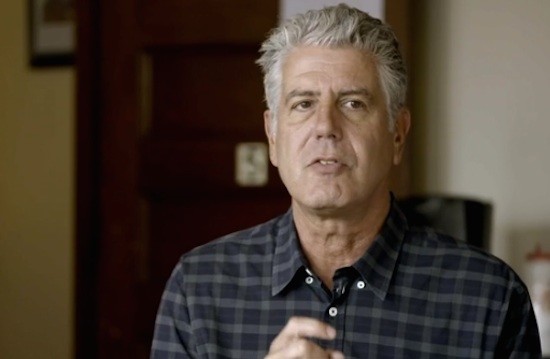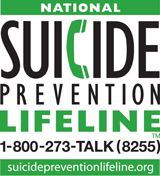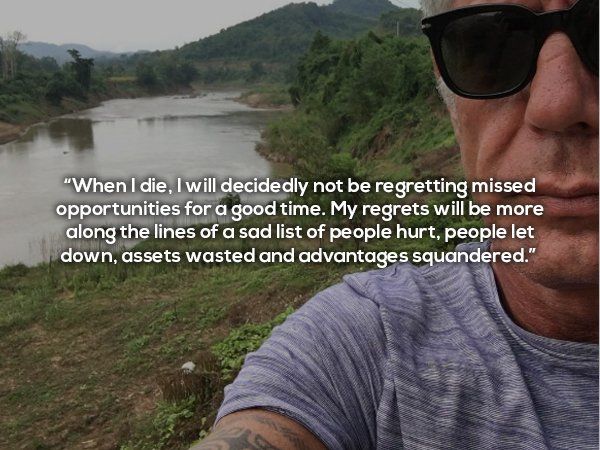Anthony Bourdain: Shining a Light on Suicide, Addiction and Depression

The deaths by suicide of Anthony Bourdain and Kate Spade last week, brought mental health and suicide to the forefront. Perhaps that is the only positive that can be gleaned from the tragic and avoidable loss of such robust, talented people.
When Celebrity Shines a Light…
In the celebrity magazine Us Weekly, there is a feature called: Stars – They’re Just Like Us! Full color photos depict movie idols doing mundane things, like walking dogs or shopping in farmer’s markets.
I thought of that catch phrase when I heard about Anthony Bourdain’s death. Because, his suicide seemed personal. And more difficult for me to take. Maybe it’s because he is such a national treasure – so visible. Or maybe because he has always seemed vulnerable and dark beneath the happy-chappy bravado.
In any case, back-to-back celebrity deaths have shone a light on the growing problem of suicide in the United States. Stars – they are just like us – isolated, depressed and disconnected.
Increase in Suicide Rates in the US
 According to the National Institute of Mental Health (NIMH), the US suicide rate has increased by 28% in the 17 year period from 1999 to 2016.
According to the National Institute of Mental Health (NIMH), the US suicide rate has increased by 28% in the 17 year period from 1999 to 2016.
There is no single factor that explains the increase in suicide deaths. And it’s not just a mental health issue. The Centers for Disease Control & Prevention (CDC) says, “A combination of individual, relationship, community and societal factors contribute to the risk of suicide.”
And the CDC Study on Suicide Risk and Protection sites “suicide risk factors” as:
- Family history of suicide or child maltreatment
- Previous suicide attempts
- History of mental disorders and clinical depression
- History of alcohol and substance abuse
- Isolation, loss, hopelessness
- Physical illness
- Impulsiveness, aggression
- Barriers to accessing mental health facilities
- Unwillingness to seek help because of stigma
Learning to cope with loss and process difficult emotions is essential in suicide prevention. A “safety plan” and connectedness are key…

The death by suicide of someone as beloved as Anthony Bourdain begs the questions, “Why?” And, “Could it have been prevented?” The CDC says, “Protective factors buffer individuals from suicidal thoughts and behavior.” We can only assume that Bourdain’s “protective factors” failed him. And that life just became too painful.
The CDC “protective factors for suicide” include:
- Effective clinical care for mental, physical and substance use disorders
- Easy access to clinical interventions and support
- Family and community support – connectedness
- Ongoing mental health care support
- Development of skills in problem solving and conflict resolution
Most people who are suicidal do not want to die. Reaching out to those who are suffering could save a life. Let someone know you are available and treat them with respect and compassion.
Vonnie Woodrick i understand love heals 1.800.273.TALK
The Connection Between Addiction, Depression and Suicide
Mood disorders, like depression, are often co-occurring with substance use disorders. In fact, about 20 percent of Americans with an anxiety or mood disorder also have a substance use disorder. And about 20 percent of those with a substance use problem also have a mood disorder, or depression.
When high anxiety strikes, those who suffer often self-medicate to ease the pain. But, it’s a vicious cycle, not an end solution. And although depression isn’t the only reason for suicidal thoughts, it is certainly a major factor. Depression was a debilitating condition for Anthony Bourdain. And he was a recovering heroin addict who continued to drink alcohol.
Alcohol and drugs are the worse possible “medication” for depression. According to the Anxiety Association of America (ADAA) one problem will often make the other worse. But there is help available. Treatment includes therapy, medical assistance such as antidepressants, and connection with support groups and community.
One of My Favorite Episodes…
In one of my favorite episodes of Parts Unknown (2014), Anthony Bourdain goes back to Provincetown, Massachusetts where he had his first experience with heroin. In a support group at a storefront called the “Recovery Project” he shared his thoughts about his addiction.
He looked tanned and healthy, but so present and vulnerable (and knowing what we know now) it brings tears to your eyes. He says:
The first time I shot up I looked at myself in the mirror with a big grin. Something was missing in me, whether it was a self-image situation, whether it was a character flaw… There was some dark genie inside me that led me to dope… Anybody could find themselves very easily in that situation. I looked in a mirror and I saw somebody worth saving or I wanted to at least try real hard and save. I look back on that and I think about what I’ll tell my (seven-year-old) daughter. That was daddy, no doubt about it. But I hope I’ll be able to say that was daddy then, this is daddy now. That I’m alive and living in hope.
Anthony Bourdain Parts Unknown
Would that it were true… I am grateful however, that someone so forefront in the public eye, someone who has brought such pleasure to many, did not die quietly. It helps to mitigate the stigma that still clings to those with mental health disorders. It shines a light on a growing problem and allows us to speak up and offer help, to those who live with the “dark genies” of depression, addiction and suicidal thoughts.



